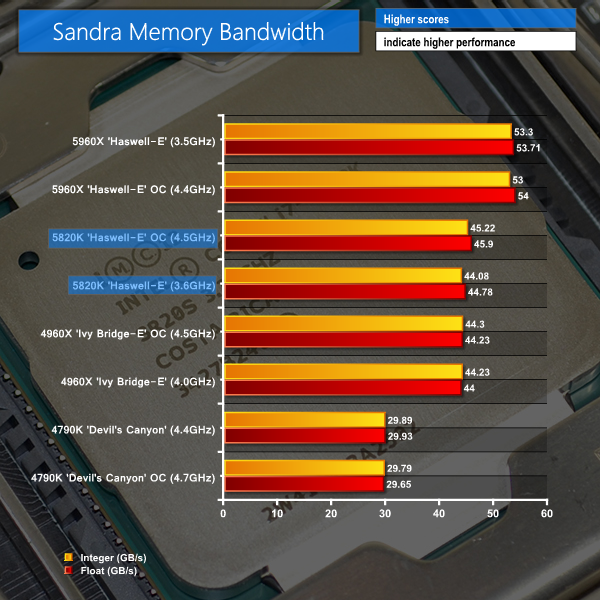Sandra Processor Arithmetic
The Dhrystone Integer performance test for all Haswell-powered chips uses the AVX2 instruction set, while the Ivy Bridge-E part relies upon SSE4.2 instructions.
Sandra Cryptographic
The Hashing Bandwidth test for all Haswell-powered chips uses the AVX2 instruction set, while the Ivy Bridge-E part relies upon AVX instructions.
Sandra Memory Bandwidth
The 5820K, 5960X, and 4960X all use quad-channel memory interfaces, with the latter relying upon DDR3 modules and the former two supporting (the still immature) DDR4 technology. Devil's Canyon supports dual-channel DDR3 memory.
At first glance it looks like the 5820K is getting outperformed by IVB-E's 4960X in Sandra's Processor Arithmetic test. An advantage in the Dhrystone performance for the 4960X indicates that its SSE4.2 instruction set allows it to score higher in the Sandra benchmark, when compared to the AVX2 instructions used by all Haswell-based chips. AVX-based performance for the Haswell chips is far superior to previous micro-architectures, as proven by the Whetstone single-float scores.
Any negativities that the AVX2 instruction set may have provided in arithmetic performance are quickly turned into clear strengths for cryptographic operations. Hashing performance for the 5820K is significantly better than the 4960X and its AVX instruction set. The 5820K's cryptographic performance advantages over the 4790K are in the region of 42% when both chips are overclocked. That's a big difference to users who regularly deal with large amounts of protected data.
Memory bandwidth is somewhat secluded from processor performance. The data does, however, show differences between the quad- and dual-channel memory interfaces that high-end and mid-range processors support, respectively. Clearly the HEDT chips' quad-channel memory interface offers significantly higher bandwidth than a dual-channel alternative, but that performance comes at increased RAM cost. What our chart does not show is the higher memory latency that DDR4 modules will operate at when compared to DDR3 kits of a similar running frequency.
It is also worth noting that memory bandwidth differences between the Haswell-E 5960X and 5820K chips are due to the use of different memory speeds and timings, not the processors themselves.
 KitGuru KitGuru.net – Tech News | Hardware News | Hardware Reviews | IOS | Mobile | Gaming | Graphics Cards
KitGuru KitGuru.net – Tech News | Hardware News | Hardware Reviews | IOS | Mobile | Gaming | Graphics Cards






MKV is not a video format, it is a container. What format was the video in for the conversion? Odds are it was already an MP4 encoded using H.264 which was Stored as a stream inside the MKV file – meaning your test was just resampling the original file and not really encoding anything.
You are correct. As suggested, the file uses an MPEG-4 part 10 (H.264) codec and is simply contained within the MKV container. The operation being run is more of a remuxing process than an encode – it takes the H.264 video out of a MKV container and puts it into a MP4 container.
The test results are still perfectly valid and highlight differences in processing power. I will look into a ‘true’ encode test for future usage.
Well, a couple things about video encoding you should probably take into account. 1) Your using Handbreak, which uses Gstreamer, which doesn’t natively use Intel’s Quick Sync Video – but it does Use VCE (the Radeon 280x in your test build supports VCE) 2) so while you where testing the processors ability to pass information along, you won’t actually be testing the SIP components on the Processors unless you use a program that fully utilizes the Gen2 and Gen3 Intel Quick Sync technologies in the IB-E or the Haswell.
So unless you use a program that isn’t routing directly through the video card, you won’t actually be testing the processor with video encoding.
But the issue is that QuickSync doesn’t exist on the platform LGA2011, that is part of the platform 1155/1150 as they have their GPU builtin on the die, unlike the LGA2011 counterparts.
One of the processors being compared here (the 4790k) has Intel Quick Sync. just because the 5820k doesn’t, doesn’t mean the tests used shouldn’t support it. I was also bringing up the fact that any transcoding done on this specific build will utilize the GPU’s video encoding technology and not really be a true representation of the CPU’s encoding ability.
Could somebody help me pls?
I have a sabertooth z97 mark 1 and it is supposed to run 5th gen processor (updating it), but the thing is that the socket the mother has is an 1150 and I see the 5th gen are lga 2011 or 2011-v3. Here comes my question.
After my BIOS is upgraded it’s supposed to work with the lga 2011 processors?
my i7 5820k at stock speeds idles at around 29 degrees celcius with an h100i and all case fans at max. is that ok???
That’s typical, provided the ambient temperature is in the low 20s. Mine’s currently at 4.5ghz idles around 33c with a custom loop
Denise, I imagine you’ve gotten the answer to this question by now, but the 1150 and the 2011 sockets are unfortunately physically different so a BIOS update will not let you use any of the Haswell-E CPU’s in the 1150 socket.